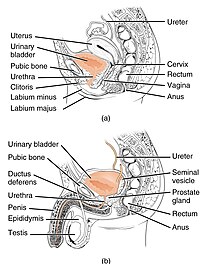
Photo from wikipedia
BACKGROUND AND AIM Urinary tract infection (UTI) is the second most frequent infection in human, and uropathogenic Escherichia coli is its most common cause. Although antibiotics are the standard treatment… Click to show full abstract
BACKGROUND AND AIM Urinary tract infection (UTI) is the second most frequent infection in human, and uropathogenic Escherichia coli is its most common cause. Although antibiotics are the standard treatment for UTI, they can cause harmful effects on gut microbiome and increase the rate of existing drug-resistant bacteria, which make the vaccine research reasonable. This study was conducted to construct a Killed but Metabolically Active (KBMA) E. coli strain, and to determine its characteristics as a possible vaccine candidate for UTI, which will be evaluated in further investigations. METHODS The uvrB gene of uvrABC excision repair system of E.coli was deleted to construct a ΔuvrB mutant, lacking repairing system of intercross linkages between DNA strands. To construct KBMA strain, the ΔuvrB mutant was PUVA-treated, using different doses of 8-methoxypsoralen (8-MOP) followed by different doses of ultraviolet A (UVA) irradiation (365 nm), until the optimal doses of each were achieved. Then, different characteristics of the PUVA-treated E. coli (with the optimal doses) were assessed, using cell counting, colony formation assay, MTT and XTT assays, fluorescent staining, and flow cytometry. RESULTS PUVA treatment's optimal dose for E. coli isolates was 150 ng/ml 8-MOP plus 1000 mj/cm2 UVA. While the PUVA-treated isolates had a significant decrease in cell counting, the fluorescent dying of the un-grown parts of the culture plates revealed living bacteria with bizarre shapes. Meanwhile, MTT and XTT assays demonstrated the metabolic activity of these bacteria and flow cytometry confirmed their aliveness. CONCLUSION These PUVA-treated bacteria, with metabolic activity and proliferation inability, seem to be good enough to be tested in vitro and in vivo as a candidate for vaccine against UTI. Therefore it seems the first step toward development of a vaccine candidate is successfully done. The immunogenicity and protectivity of these treated bacteria is under evaluation.
Journal Title: Microbial pathogenesis
Year Published: 2018
Link to full text (if available)
Share on Social Media: Sign Up to like & get
recommendations!